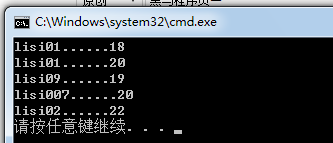Set接口中的方法和Collection一致。
|--HashSet:内部数据结构是哈希表,是不同步的。
|--TreeSet:可以对Set集合中的元素进行排序,是不同步的。
HashSet
1.HashSet保证元素唯一性的方式
HashSet通过元素的两个方法:hashCode()和equals来完成,如果元素的hashCode值相同,才会判断equals是否为true,如果元素的hashCode值不同,不会调用equals;
2.存入到HashSet集合中的自定义对象,一般要复写hashCode和equals方法,这两个方法是集合底层自动调用的;
示例:
import java.util.*;
/*
往hashSet集合中存入自定对象
姓名和年龄相同为同一个人,重复元素。
*/
class HashSetTest
{
public static void sop(Object obj)
{
System.out.println(obj);
}
public static void main(String[] args)
{
HashSet hs = new HashSet();
hs.add(new Person("a1",11));
hs.add(new Person("a2",12));
hs.add(new Person("a2",12));
hs.add(new Person("a3",13));
sop("a1:"+hs.contains(new Person("a2",12)));
Iterator it = hs.iterator();
while(it.hasNext())
{
Person p = (Person)it.next();
sop(p.getName()+"::"+p.getAge());
}
}
}
class Person
{
private String name;
private int age;
Person(String name,int age)
{
this.name = name;
this.age = age;
}
public int hashCode()
{
System.out.println(this.name+"....hashCode");
return name.hashCode()+age*39;
}
public boolean equals(Object obj)
{
if(!(obj instanceof Person))
{
return false;
}
Person p = (Person)obj;
System.out.println(this.name+"...."+p.name);
return this.name.equals(p.name) && this.age ==p.age;
}
public String getName()
{
return name;
}
public int getAge()
{
return age;
}
}

哈希表确定元素是否相同
1. 判断的是两个元素的哈希值是否相同。
如果相同,再判断两个对象的内容是否相同。
2. 判断哈希值相同,其实判断的是对象的HashCode方法。判断内容相同,用的是equals方法。
P.S.
如果哈希值不同,不需要判断equals。
TreeSet
1.TreeSet可以对set集合中的元素排序,底层数据结构是二叉树;
2.TreeSet判断元素唯一性的方式:就是根据比较方法的返回结果是否是0,是0,就是相同元素,不存。
示例:
class TreeSetDemo
{
public static void sop(Object obj)
{
System.out.println(obj);
}
public static void main(String[] args)
{
TreeSet ts = new TreeSet();
ts.add(new Student("lisi02",22));
ts.add(new Student("lisi007",20));
ts.add(new Student("lisi09",19));
ts.add(new Student("lisi01",19));
Iterator it = ts.iterator();
while(it.hasNext())
{
Student stu = (Student)it.next();
sop(stu.getName()+"......"+stu.getAge());
}
}
}
class Student implements Comparable //该接口强制让学生具备比较性。
{
private String name;
private int age;
Student(String name,int age)
{
this.name = name;
this.age = age;
}
public int compareTo(Object obj)
{
if(!(obj instanceof Student))
throw new RuntimeException("不是学生对象");
Student s = (Student)obj;
System.out.println(this.name+"..compareto...."+s.name);
if(this.age>s.age)
return 1;
if(this.age ==s.age)
return this.name.compareTo(s.name);
return -1;
}
public String getName()
{
return name;
}
public int getAge()
{
return age;
}
}
TreeSet排序的第一种方式:
让元素自身具备比较性。
元素需要实现Comparable接口,覆盖compareTo方法、这种方式也称为元素的自然顺序,或者叫做默认顺序。
TreeSet的第二种排序方式:
当元素自身不具备比较性时,或者具备的比较性不是所需要时。
这时就需要让集合自身具备比较性。
在集合初始化时,就有了比较方式。
PS:
当元素自身不具备比较性,或者具备的比较性不是所需要的。
这时需要让容器自身具备比较性。
定义了比较器,将比较器对象作为参数传递给TreeSet集合的构造函数。
当两种排序都存在时,以比较器为主。
定义一个类,实现Comparator接口,覆盖compare方法。
示例:
import java.util.*;
class TreeSetDemo2
{
public static void sop(Object obj)
{
System.out.println(obj);
}
public static void main(String[] args)
{
TreeSet ts = new TreeSet(new MyCompare());
ts.add(new Student("lisi02",22));
ts.add(new Student("lisi007",20));
ts.add(new Student("lisi09",19));
ts.add(new Student("lisi01",18));
ts.add(new Student("lisi01",20));
Iterator it = ts.iterator();
while(it.hasNext())
{
Student stu = (Student)it.next();
sop(stu.getName()+"......"+stu.getAge());
}
}
}
class Student implements Comparable //该接口强制让学生具备比较性。
{
private String name;
private int age;
Student(String name,int age)
{
this.name = name;
this.age = age;
}
public int compareTo(Object obj)
{
if(!(obj instanceof Student))
throw new RuntimeException("不是学生对象");
Student s = (Student)obj;
//System.out.println(this.name+"..compareto...."+s.name);
if(this.age>s.age)
return 1;
if(this.age ==s.age)
return this.name.compareTo(s.name);
return -1;
}
public String getName()
{
return name;
}
public int getAge()
{
return age;
}
}
class MyCompare implements Comparator
{
public int compare(Object o1,Object o2)
{
Student s1 = (Student)o1;
Student s2 = (Student)o2;
int num = s1.getName().compareTo(s2.getName());
if(num == 0)
{
if(s1.getAge()>s2.getAge())
return 1;
if(s1.getAge() == s2.getAge())
return 0;
}
return -1;
}
}
二、泛型
JDK1.5版本以后出现新特性。用于解决安全问题,是一个安全机制。
好处
1.将运行时期出现的问题ClassCastException,转移到了编译时期。
方便于程序员解决问题,让运行事情问题减少,安全,
2.避免了强制转换麻烦。
泛型格式:通过<>来定义要操作的引用数据类型。
在使用java提供的对象时,什么时候写泛型呢?
通常在集合框架中很常见。
只要见到<>,就要定义泛型。
其实<>就是用来接收类型的。
当使用集合时,将集合中要存储的数据类型作为参数传递传递到<>即可。
示例:
import java.util.*;
class GenericDemo
{
public static void main(String[] args)
{
ArrayList<String> a1 = new ArrayList<String>();
a1.add("abc01");
a1.add("abc01ss");
a1.add("abc01dsfds");
//a1.add(4);//a1.add(new Integer(4));
Iterator<String> it = a1.iterator();
while(it.hasNext())
{
String s = it.next();
System.out.println(s+":"+s.length());
}
}
}
泛型类
1.类中要操作的引用数据类型不确定的时候,早起定义Object来完成扩展,现在定义泛型来完成扩展,例:
class Util<QQ>
{
private QQ q;
public void setObject(QQ q)
{
this.q=q;
}
public QQ getObject()
{
return q;
}
}2.泛型类定义的泛型,在整个类中有效,如果被方法使用,那么泛型类的对象明确要操作的具体类型后,所有要操作的类型就已经固定了; 为了让不同方法可以操作不同类型,而且类型还不确定,那么可以将泛型定义在方法上,例:
class Demo<T>
{
public void show(T t)
{
System.out.println("show:"+t);
}
public <Q> void print()
{
System.out.println("print:"+q);
}
}3.特殊之处:
静态方法不可以访问类上定义的泛型。
如果静态方法操作的引用数据类型不确定,可以将泛型定义在方法上。
class Demo<T>
{
public void show(T t)
{
System.out.println("show:"+t);
}
public <Q> void print(Q q)
{
System.out.println("print:"+q);
}
public static <W> void method(W t)
{
System.out.println("method:"+t);
}
}
class GenericDemo4
{
public static void main(String[] args)
{
Demo <String> d = new Demo<String>();
d.show("haha");
//d.show(4);
d.print(5);
d.print("hehe");
Demo.method("hahahahha");
/*
Demo d = new Demo();
d.show("haha");
d.show(new Integer(4));
d.print("heihei");
Demo<Integer> d = new Demo<Integer>();
d.show(new Integer(4));
d.print("hah");
Demo<String> d1 = new Demo<String>();
d1.print("haha");
d1.show(5);
*/
}
}4.泛型定义在接口上
示例:
interface Inter<T>
{
void show(T t);
}
/*class InterImpl implements Inter<String>
{
public void show(String t)
{
System.out.println("show:"+t);
}
}
*/
class InterImpl<T> implements Inter<T>
{
public void show(T t)
{
System.out.println("show:"+t);
}
}
class GenericDemo5
{
public static void main(String[] args)
{
InterImpl<Integer> i = new InterImpl<Integer>();
i.show(4);
}
}5.泛型的限定
泛型的限定:
? extends E:可以接收E类型或者E的子类型。上限。
? super E: 可以接收E类型或者E的父类型。
示例:
class GenericDemo6
{
public static void main(String[] args)
{
/*
ArrayList<String> a1 = new ArrayList<String>();
a1.add("abc1");
a1.add("abc2");
a1.add("abc3");
a1.add("abc4");
ArrayList<Integer> a11 = new ArrayList<Integer>();
a11.add(4);
a11.add(7);
a11.add(6);
a11.add(8);
printColl(a11);
printColl(a1);
*/
ArrayList<Person> a1 = new ArrayList<Person>();
a1.add(new Person("abc1"));
a1.add(new Person("abc2"));
a1.add(new Person("abc3"));
printColl(a1);
ArrayList<Student> a11 = new ArrayList<Student>();
a11.add(new Student("abc11"));
a11.add(new Student("abc22"));
a11.add(new Student("abc33"));
printColl(a11);//ArrayList<String>a1 = new ArrayList<Person>();error
}
public static void printColl(ArrayList<? extends Person> a1)
{
Iterator<? extends Person> it = a1.iterator();//<?>占位符 ,不明确时
while(it.hasNext())
{
System.out.println(it.next().getName());
}
}
/*
public static void printColl(ArrayList<?> a1)//ArrayList<String> a1 = new ArrayList<Integer>();error
{
Iterator<?> it = a1.iterator();//<?>占位符 ,不明确时
while(it.hasNext())
{
System.out.println(it.next());
}
}*/
}
class Person
{
private String name;
Person(String name)
{
this.name = name;
}
public String getName()
{
return name;
}
}
class Student extends Person
{
Student(String name)
{
super(name);
}
}
class Student implements Comparable<Student>//<? super E>
{
public int compareTo(Person s)
{
this.getName()
}
}
class Comp implements Comparator<Person>
{
public int compare(Person s1, Person s2)
{
return s1.getName().compareTo(s2.getName());
}
} 




















 9546
9546











 被折叠的 条评论
为什么被折叠?
被折叠的 条评论
为什么被折叠?








